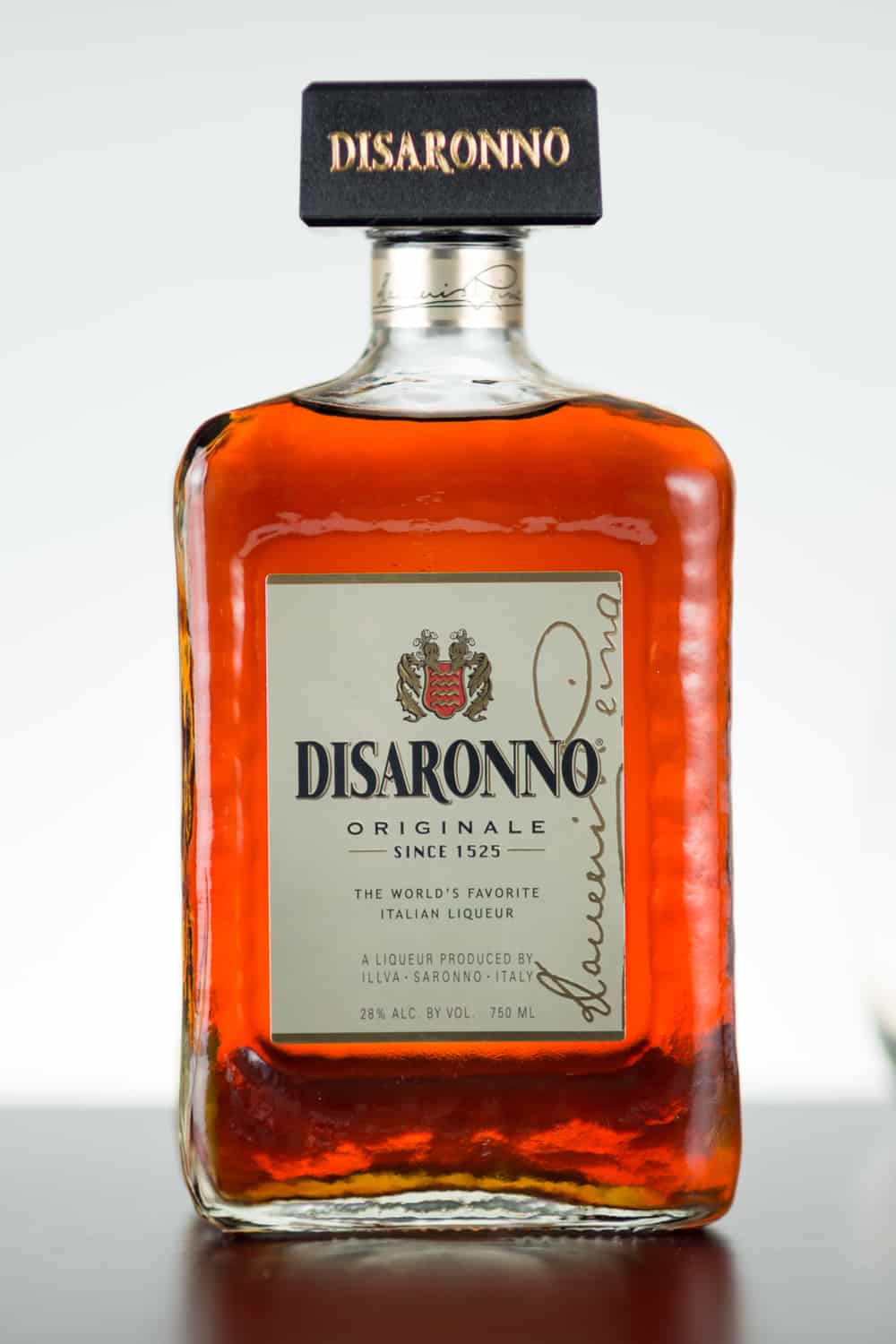Much like any other food and drink, the longevity of amaretto depends on how you store it. In some cases, it can last up to two decades, or it can spoil in several days.
Have you found an old bottle in your cabinet, or do you want to know how long it can last before buying one? Either way, we’re here to solve the mystery.
Continue reading to learn about its shelf life, storage, and signs of spoilage.
Table of Contents
Does Amaretto Go Bad
Amaretto is high-proof alcohol that doesn’t go bad as easily. It can definitely spoil, but it takes years for this to happen, especially if you stored it properly.
It can go bad, just not in the conventional terms like other drinks and foods. Instead, it first starts to lose its potency before losing the flavor, aroma, and quality.
It’s unlikely this drink will ever have mold, but you can expect it to lose its taste after a while. Even in this case, it’s still safe to consume, just not as fun.
Checking if it’s still good takes a few minutes and is quite simple.
How Long Does Amaretto Last
Arguably, amaretto has an indefinite shelf life if you store it properly. It’s pretty much the same as other high-proof alcohol where storage plays the most significant role.
You may have noticed a best-by date on your bottle. It’s stamped to indicate how long it will remain at peak quality. This isn’t an expiration date, so the liquor will likely still be safe to consume past that date.
How long it lasts depends on how you store it. An unopened bottle can last for several years, while an opened one is good for about six months.
Finding the right spot for the bottle is also quite important. No alcohol likes to be exposed to light, air, and heat, and amaretto is no different.
Leaving the bottle open and in a warm environment will cause it to go bad rather quickly. These are general guidelines to follow for optimal flavor.
Its long shelf life is ideal for people who only consume a little at a time.
Pantry |
|
| Opened Bottle | 5 years |
| Unopened Bottle | Up to 20 years |
Again, different factors affect its longevity, so make sure to consider this when determining if your amaretto is still good.
Tips to Tell if Amaretto Has Gone Bad
Amaretto has high alcohol content (21% to 28% ABV), so it’s safe to assume that it rarely goes bad. But, things happen, and your liquor might change in terms of quality, taste, and appearance.
If you only drink it from time to time, it’s best to check it before consuming it. This is especially the case if you’re not sure about how it was stored.
Amaretto can only go bad if not stored correctly, and even then, it takes a while to show any signs of spoilage. As we said, the only thing that can cause it to go bad quickly is leaving an open bottle near a heat source.
Since it’s unlikely you kept it this way, your amaretto is possibly still good. Here’s what you can do to check:
Smell it
Amaretto has a pleasant, sweet smell, so you’ll recognize any change quite quickly. If it’s bad, it probably doesn’t smell as nice, or at least not as strongly. It’s best to throw away the whole bottle if the smell has changed to one that doesn’t seem right. Your drink is probably still good if the smell isn’t as strong but still pleasant.
Look at it
You might want to pour a little amaretto in a shot glass to inspect its appearance. If you see any color change or things floating in the liquor, it’s time to throw it away. This is unlikely to happen if you store it properly, but you never know. In some cases, it’s better to be safe than sorry.
Taste it
If you opened the bottle several years ago and had it stored in different places, you should always take a sip to check its taste. It won’t taste like anything spoiled, so you might have trouble determining if it’s good or not. This is usually what happens to people who don’t drink it so often. What you’ll notice is that the taste is no longer as intense. It’s likely still safe to consume, so you can use it in cocktails, ice cream, baking, and cooking.
Tips to Store Amaretto
Amaretto doesn’t need much to stay good for years. All it needs is a dark and dry place far from any heat source. It likes room temperature or below, but this depends on how hot it gets where you live.
If you live in a hot climate, you might want to keep it in your fridge or anywhere colder. However, it doesn’t like temperature changes, so try not to take it in and out of the refrigerator too frequently.
Keeping it away from air and heat is critical for its longevity, which is why proper storage matters so much. It doesn’t matter how often you use it and how long it takes you to go through the bottle – proper storage will ensure maximum flavor and quality throughout.
Check some storage tips to prolong its shelf life:
Prevent oxidation
Oxidation ruins alcohol, changing the flavor quite quickly. The best way to avoid this is by closing the bottle tightly each time after pouring yourself a drink. You might also want to transfer it into a smaller bottle or jar if you only have a little left. This way, you limit its exposure to air and prevent oxidation.
Choose an airtight container
When choosing a new bottle for your amaretto, you want to make sure it’s an airtight one. Only an airtight bottle or jar can keep the air out, preventing air exposure and oxidation. As we said, oxidation changes the properties of your alcohol, ruining the flavor and aroma. Direct air exposure causes it to lose its good stuff quite quickly, so make sure the bottle of your choice is airtight.
Keep it away from heat
Exposing amaretto to heat will cause it to go bad rapidly. It’s a sugary drink, so it doesn’t take long to spoil when exposed to high temperatures. For this reason, make sure to find the right place to keep the bottle. In most cases, your kitchen cabinet or pantry works fine. If it’s an unopened bottle, you can keep it on a shelf in your living room along with other liquor in your collection. However, it should always be at room temperature and away from sunlight.
Avoid sugary buildup
As we said, amaretto is a sugary drink, so you might notice buildup on the mouth of the bottle. This happens to everyone who uses amaretto regardless of how frequently. It’s important to avoid this from happening because sugar is ideal for bacteria development. Wipe the lid and the bottle after each use to ensure it’s clean so that no sugar can build up.
The Risk of Consuming Expired Amaretto
Expired amaretto is usually a no threat to anyone’s health. It typically comes with a best-by date, so don’t confuse that with an expiration date.
Your amaretto might still be good years after the date stamped on the bottle. It’s usually there to indicate how long it’ll stay at peak quality, so it doesn’t have much to do with safety.
Its high alcohol content keeps it good almost indefinitely if you store it the right way. So, if your bottle had a tight seal and was in a dark and cool spot, it’s likely still good to go.
The only scenario where you might end up sick is if the taste and smell are off due to improper storage. Sugary buildup potentially packed with bacteria might also make you sick.
Still, these things rarely happen, and when they do, you may be nauseous, but it should last too long to be worrying.
Can you Freeze amaretto?
Technically, you could, but you’d need a lower temperature than what your freezer can offer. Amaretto has a high freezing point due to its high alcohol content.
It doesn’t freeze under most circumstances, making the entire task quite tricky to do at home. On top of that, amaretto doesn’t really benefit from freezing.
Even if you manage to freeze it, this does nothing for its preservation and longevity and is pointless. Another problem you might encounter is the liquid expanding as it freezes.
Full bottles and unopened ones can break or explode in the freezer once the liquid inside expands.
Summary
Amaretto is versatile since it goes well with many other drinks and foods. You can drink it straight or use it in cocktails, coffees, baking, cooking, and more.
Best of all – it’s nearly impossible for it to go bad. It doesn’t require much in terms of storage, and it can last for up to 20 years, preserving the same taste and flavor.



